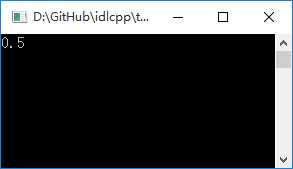标签:
上一篇在这 C++混合编程之idlcpp教程Python篇(4)
第一篇在这 C++混合编程之idlcpp教程(一)
与前面的工程相似,工程PythonTutorial3中,同样加入了三个文件:PythonTutorial3.cpp, Tutorial3.i, tutorial3.py。其中PythonTutorial3.cpp的内容基本和PythonTutorial2.cpp雷同,不再赘述。
首先看一下Tutorial3.i的内容:
namespace tutorial
{
struct Point
{
float x;
float y;
meta:
Point();
Point(float a, float b);
Point(const Point ref pt);
$*
Point()
{}
Point(float a, float b)
{
x = a;
y = b;
}
*$
};
struct Shape
{
abstract float getArea();
$$ virtual ~Shape() {}
};
struct Triangle : Shape
{
Point m_vertices[$3];
meta:
static Triangle new New();
$*
virtual float getArea()
{
return fabs(m_vertices[0].x * m_vertices[1].y
+ m_vertices[1].x * m_vertices[2].y
+ m_vertices[2].x * m_vertices[0].y
- m_vertices[0].x * m_vertices[2].y
- m_vertices[1].x * m_vertices[0].y
- m_vertices[2].x * m_vertices[1].y) * 0.5;
}
static Triangle* New()
{
return new Triangle;
}
*$
};
}
在这里仍然有struct Point。 引入了基类 struct Shape。其中这一行
abstract float getArea();
表示声明一个纯虚函数,相当于C++中的
virtual float getArea() = 0;
如果不是纯虚函数,使用关键字virtual代替abstract即可。
新加入了类型 Triangle
struct Triangle : Shape
与C++一样,用 : 表示继承。因idlcpp表示的是接口信息,所以只有公有继承。与C++不同,idlcpp并没有public, protected, private这三个关键字。
然后是数据成员m_vertices;
Point m_vertices[$3];
idlcpp只关心接口的信息,在其语法分析部分,只能看见Point m_vertices[]。数字3需要用插入代码的方式。其中$表示直接连在后面的一个标识符或整数(实际上是由字母,下划线和数字组成的串)将插入到生成的C++头文件对应的位置上。下两行
meta:
static Triangle new New();
声明了一个名为New的静态函数,其实现代码就在后续的类型声明内,所以此处用meta阻止在头文件中生成函数声明,如前所述,idlcpp如果看见了构造函数的声明,会生成静态函数New,所以此时不能出现构造函数的声明,以免名字冲突。对照一下后面实现部分的C++声明
static Triangle* New()
这里和C++不一致的地方是少了一个*并且多了一个new。new是idlcpp中的一个关键字,放在函数返回值类型与函数名之间,表示函数内部以new的形式创建了一个对象,返回其指针,外界需要用delete的形式删除它(还有另一种关于引用计数的情况,暂不讨论)。在脚本语言中一般自带垃圾收集机制,脚本语言自动管理内存的分配释放。程序员一般不用关心何时删除对象这样的问题,而在C++中在堆上分配对象的生命期一般由程序员维护。为处理其间的差异,idlcpp在函数声明的返回值类型部分有如下几种形式:
|
idlcpp声明 |
C++声明 |
实现 |
|
typeName |
typeName |
返回值 |
|
typeName ref |
typeName& |
返回引用 |
|
typeName ptr |
typeName* |
返回指针 |
|
typeName new |
typeName* |
返回指针,外界需要delete,或者增加了引用计数,外界需要release |
|
typeName new [] |
typeName* |
返回指针,外界需要delete[] |
例如下面的C++代码:
int g_a;
int* getGlobal()
{
return &g_a;
}
int* getNew()
{
return new int;
}
int* getNewArray(int count)
{
return new int[count];
}
三个函数的返回值类型都是int*,但对于后面两个,分别要用delete 和delete[]释放内存,就语法层面看,从函数的声明不能区分这些情况。只能由程序员根据实际情况进行不同的处理。而在脚本语言中并不希望看到显示的删除对象的调用。所以idlcpp通过语法层面的声明,在生成的元数据代码中进行区分,然后由运行时库(pafcore.dll)进行处理。
编译后生成的Tutorial3.h的内容如下:
//DO NOT EDIT THIS FILE, it is generated by idlcpp
//http://www.idlcpp.org
#pragma once
#include "./Tutorial3.h"
namespace tutorial{ struct Triangle; }
namespace tutorial
{
struct Point
{
public:
float x;
float y;
public:
static Point* New();
static Point* New(float a,float b);
static Point* NewArray(unsigned int count);
static Point* Clone(const Point& pt);
Point()
{}
Point(float a, float b)
{
x = a;
y = b;
}
};
struct Shape
{
public:
virtual float getArea() = 0 ;
virtual ~Shape() {}
};
struct Triangle : public Shape
{
public:
Point m_vertices[3];
virtual float getArea()
{
return fabs(m_vertices[0].x * m_vertices[1].y
+ m_vertices[1].x * m_vertices[2].y
+ m_vertices[2].x * m_vertices[0].y
- m_vertices[0].x * m_vertices[2].y
- m_vertices[1].x * m_vertices[0].y
- m_vertices[2].x * m_vertices[1].y) * 0.5;
}
static Triangle* New()
{
return new Triangle;
}
};
}
内容基本上都是和Tutorial3.i中一一对应的。
然后看一下脚本tutorial3.py的内容:
import pafpython;
paf = pafpython.paf;
triangle = paf.tutorial.Triangle();
triangle.m_vertices[0] = paf.tutorial.Point(0,0);
triangle.m_vertices[1] = paf.tutorial.Point(0,1);
triangle.m_vertices[2] = paf.tutorial.Point(1,1);
print(triangle.getArea()._);
创建了一个tirangle对象,然后设置数据成员,此处运行时能够检测下标的范围为0至2,如果超出范围将会报错,最后调用其基类Shape中声明的函数getArea(),因为这是虚函数,所以最终会调用到Traingle::getArea()。
编译运行结果如下图:

标签:
原文地址:http://www.cnblogs.com/fdyjfd/p/5366214.html